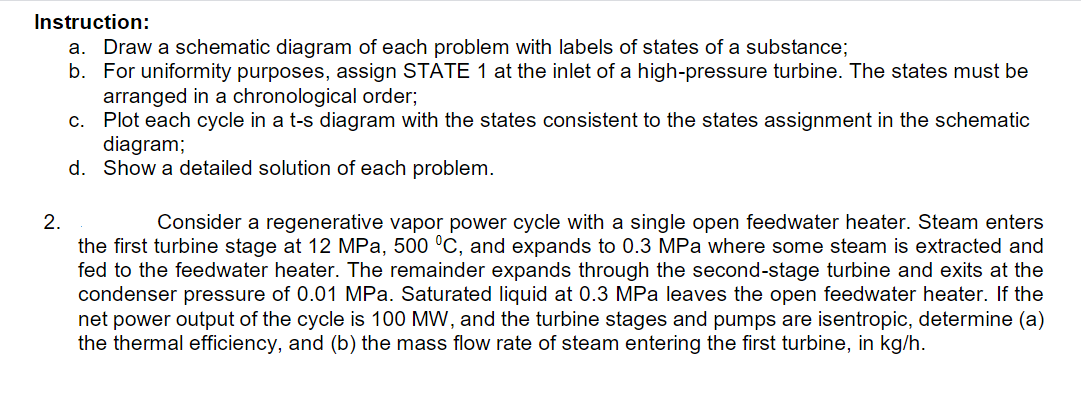Instruction: a. Draw a schematic diagram of each problem with labels of states of a substance; b. For uniformity purposes, assign STATE 1 at the inlet of a high-pressure turbine. The states must be arranged in a chronological order; c. Plot each cycle in a t-s diagram with the states consistent to the states assignment in the schematic diagram; d. Show a detailed solution of each problem. 2. Consider a regenerative vapor power cycle with a single open feedwater heater. Steam enters the first turbine stage at 12 MPa, 500 °C, and expands to 0.3 MPa where some steam is extracted and fed to the feedwater heater. The remainder expands through the second-stage turbine and exits at the condenser pressure of 0.01 MPa. Saturated liquid at 0.3 MPa leaves the open feedwater heater. If the net power output of the cycle is 100 MW, and the turbine stages and pumps are isentropic, determine (a) the thermal efficiency, and (b) the mass flow rate of steam entering the first turbine, in kg/h.
Instruction: a. Draw a schematic diagram of each problem with labels of states of a substance; b. For uniformity purposes, assign STATE 1 at the inlet of a high-pressure turbine. The states must be arranged in a chronological order; c. Plot each cycle in a t-s diagram with the states consistent to the states assignment in the schematic diagram; d. Show a detailed solution of each problem. 2. Consider a regenerative vapor power cycle with a single open feedwater heater. Steam enters the first turbine stage at 12 MPa, 500 °C, and expands to 0.3 MPa where some steam is extracted and fed to the feedwater heater. The remainder expands through the second-stage turbine and exits at the condenser pressure of 0.01 MPa. Saturated liquid at 0.3 MPa leaves the open feedwater heater. If the net power output of the cycle is 100 MW, and the turbine stages and pumps are isentropic, determine (a) the thermal efficiency, and (b) the mass flow rate of steam entering the first turbine, in kg/h.
Refrigeration and Air Conditioning Technology (MindTap Course List)
8th Edition
ISBN:9781305578296
Author:John Tomczyk, Eugene Silberstein, Bill Whitman, Bill Johnson
Publisher:John Tomczyk, Eugene Silberstein, Bill Whitman, Bill Johnson
Chapter39: Residential Energy Auditing
Section: Chapter Questions
Problem 4RQ: Performing a home energy audit starts with a visualinspection of a home and its energy systems which...
Related questions
Question
PLEASE FOLLOW THE INSTRUCTION.

Transcribed Image Text:Instruction:
a. Draw a schematic diagram of each problem with labels of states of a substance;
b. For uniformity purposes, assign STATE 1 at the inlet of a high-pressure turbine. The states must be
arranged in a chronological order;
c.
Plot each cycle in a t-s diagram with the states consistent to the states assignment in the schematic
diagram;
d. Show a detailed solution of each problem.
2.
Consider a regenerative vapor power cycle with a single open feedwater heater. Steam enters
the first turbine stage at 12 MPa, 500 °C, and expands to 0.3 MPa where some steam is extracted and
fed to the feedwater heater. The remainder expands through the second-stage turbine and exits at the
condenser pressure of 0.01 MPa. Saturated liquid at 0.3 MPa leaves the open feedwater heater. If the
net power output of the cycle is 100 MW, and the turbine stages and pumps are isentropic, determine (a)
the thermal efficiency, and (b) the mass flow rate of steam entering the first turbine, in kg/h.
Expert Solution
This question has been solved!
Explore an expertly crafted, step-by-step solution for a thorough understanding of key concepts.
Step by step
Solved in 6 steps with 8 images

Knowledge Booster
Learn more about
Need a deep-dive on the concept behind this application? Look no further. Learn more about this topic, mechanical-engineering and related others by exploring similar questions and additional content below.Recommended textbooks for you

Refrigeration and Air Conditioning Technology (Mi…
Mechanical Engineering
ISBN:
9781305578296
Author:
John Tomczyk, Eugene Silberstein, Bill Whitman, Bill Johnson
Publisher:
Cengage Learning

Refrigeration and Air Conditioning Technology (Mi…
Mechanical Engineering
ISBN:
9781305578296
Author:
John Tomczyk, Eugene Silberstein, Bill Whitman, Bill Johnson
Publisher:
Cengage Learning